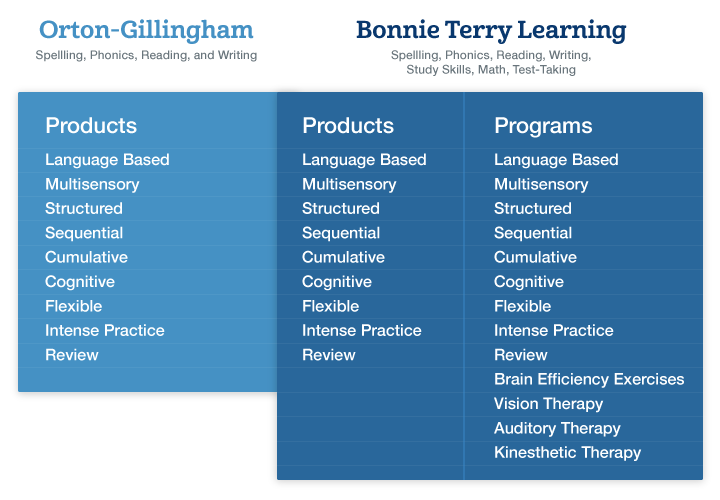
Orton-Gillingham Approach
The Orton-Gillingham approach to teaching struggling readers and those with dyslexia has been in use since the 1930s. Their program is an intensive, sequential, phonics-based system that teaches the basics of word formation before whole meanings.
This method accommodates struggling learners and those with dyslexia. It utilizes the three learning modalities, or pathways, through which people learn—visual, auditory and kinesthetic. The program is unscripted and allows for flexibility and adaptations for each student.
- Multisensory
- Sequential
- Systematic and Cumulative
- Direct Instruction
- Diagnostic Teaching
- Comprehensive and Inclusive
The system for teaching struggling learners must also include the following content:
- Phonology and Phonological Awareness
- Sound-Symbol Association
- Syllable Instruction
- Morphology
- Syntax
- Semantics/Comprehension
Bonnie Terry Learning Approach
Bonnie Terry Learning’s approach to teaching struggling readers and those with dyslexia has been in use since the 1990s. Bonnie Terry, M. Ed., BCET began designing her programs in the 1970’s after earning her degree in learning disabilities. She has had training with the Orton-Gillingham multi-sensory approach, sensory-motor integration, SIM Strategies, brain gym, learning through games, reading courses, writing courses, auditory processing, and visual processing to name a few. The Bonnie Terry Learning Awaken the Scholar Within Programs have been fine-tuned over the years and are now available to parents and schools. The programs are intensive, and the sequential, phonics-based system teaches the basics of word formation before whole meanings, as well as reading, vocabulary, comprehension, writing, study skills, test taking, and math.
Based on her work and research with students over the past several decades, Bonnie designed her BTL method specifically for struggling learners, those with dyslexia, ADHD, or in the autistic spectrum. The methods taught in the programs use all three learning modalities, or pathways, through which people learn—visual, auditory and kinesthetic. Each program is unscripted and allows for flexibility and adaptations for each student.



















